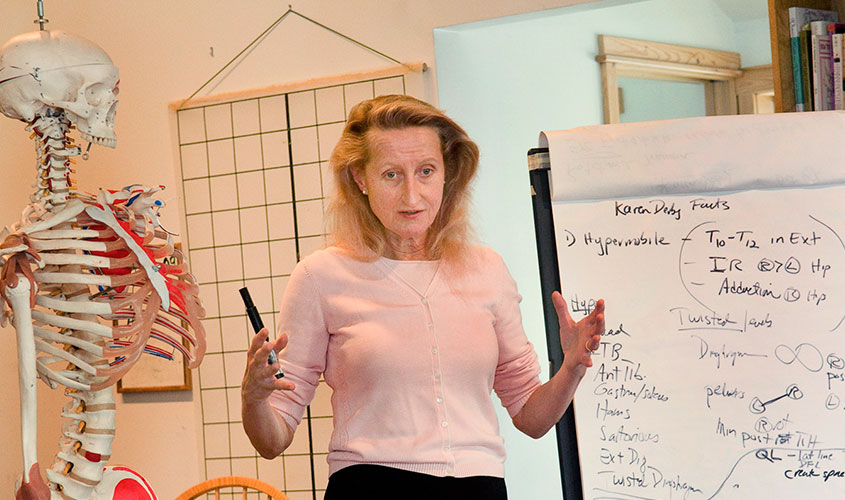Past Workshops
A well-respected structural integration trainer, Donna Bajelis has taught numerous workshops. Below is a small sampling of past workshops and an overview of the content:
A Multi-System Approach to Low Back Pain
Participants were taught to assess, identify and treat common patterns of low back pathology, using Myofascial Length Testing, myofascial release, and movement re-education.
Postural Assessment through Myofascial Length Testing
Topics explored postural assessment techniques in standing and Myofascial Length Testing out of gravity to determine primary, functional, and structural compensatory patterns. Participants learned to ojectively determine asymmetries in the tensegrity structure and develop treatment protocols involving a total body approach to enhance optimal function and achieve each individual’s natural functional spiral.
Structural Integration of the Superficial Body: A Seven-Part Series
Course 1 – Superficial Shoulder Girdle and Pelvic Girdle Pathologies
Course 2 – Superficial Upper Extremity Pathologies (Part 1)
Course 3 – Superficial Upper Extremity (Part 2) and Cervical Pathologies
Course 4 – Superficial Lower Extremity Pathologies
Course 5 – Superficial Trunk and Spinal Pathologies
Course 6 – Superficial Spine, Trunk, and Lower Extremities
Course 7 – Pathologies Affecting the Circumference Integration of the Superficial Body
Understanding and Treating Upper Extremity Pathologies
A two-day workshop at the 2012 International Association of Structural Integrators (IASI) Symposium, covering identifying, evaluating and treating upper extremity pathologies. Knowledge of myofascial meridians along with structural and functional analysis was used to uncover three-dimensional spiral rotations and restrictions. Participants learned detailed history taking and myofascial length testing for the purpose of uncovering contributing factors to upper extremity dysfunction, include myofascial, joint, neuromuscular, lymphatic, autonomic nervous system and psychological/emotional components. Creating and implementing a customized treatment approach that can globally transform their client’s posture, improve their function and decrease their pain levels was also covered.
Superficial Lines Workshop Series: A Seven-Part Series
Course 1 – Back and Front Functional Lines
Course 2 – Superficial Front Arm Line
Course 3 – Superficial Back Arm Line
Course 4 – Superficial Front Line
Course 5 – Superficial Back Line
Course 6 – Lateral Line
Course 7 – Spiral Line
Thoracic Outlet Syndrome: Patterns of Pathology and Manual Therapy Technique
This full day workshop combining lecture, hands-on learning, and skill building in the Structural Medicine paradigm related to evaluation and treatment of Thoracic Outlet Syndrome.
- Manual therapy technique and treatment strategies specifically related to myofascial meridians and tensegrity.
- Hands-on treatment skills to affect change in the myofascial structures to promote postural alignment related to pathology.
- Evaluating and molding a model of effective treatment, synthesizing the principles of Structural Medicine and utilizing standardized, reproducible objective measures.
- Understanding the fascial, neurological, lymphatic and muscular systems and the interrelationships of these systems in contributing to pathology and dysfunction.
- Fascial and neuromuscular pathology of Thoracic Outlet Syndrome.
- Recognizing structural patterns that induce certain forms of pathology of the upper extremity.
- Objective testing and documentation of restrictions and creating a treatment plan within the scope of the series.
- Understanding the spiral function of the upper extremity and its relationship to functional activities
Integrating the Pelvis for More Powerful Movement
Many clients suffer from a pelvis that is incongruent with their legs and torso. The pelvis is the powerhouse of the body, and yet many people don’t know how to access that power leaving them with less than satisfactory movement. This workshop taught how to effectively assess and test the pelvis to determine the underlying structural and functional imbalance. Practitioners acquired Structural Medicine manual and movement techniques to enhance connection and integration of the legs, pelvis and torso. Presented by Donna Bajelis and Joe Kelly.
Taking on a Tensegrity Paradigm
There is a rising demand for health care professionals who can address complex and multi-faceted issues. This series offered a powerful paradigm shift on how you assess and treat clients by utilizing a three dimensional, nonlinear, tensegrity approach to the body, and its relationship to our emotional holding and belief patterns. Participants learned to ask the right questions, understand the mechanism of injury, and gained global assessment skills that allow identification and treatment of root causes, not just localized pain. The series was divided into four parts:
- Inspiration and the Dynamic Fascial Anatomy of Breathing
- Fascial Slings: Elastic and Powerful Contralateral Movements
- Emerging Into a Vertical Expansion with Gravity: Part 1
- Emerging Into a Vertical Expansion with Gravity: Part 2
Presented by Donna Bajelis and Joe Kelly.
Functional Fascia: The Interplay Between Fascial Tensegrity, Skeletal Organization, and Movement Pattern
Today’s movement specialists deal with a diverse client population, each presenting with a unique history of injuries, movement patterns, restrictions, and pathologies. This three-part series taught how to identify structural and movement limitation in your clients. We employed Myofascial Length Testing to identify the primary movement restrictions in the three-dimensional fascial tensegrity of the body.
By developing knowledge of restrictions in the fascial lines participants learned to identify root cause in movement dysfunction. With these tools participants can differentiate themselves as an industry expert and be able to customize client’s movement/exercise programing to address areas of restriction and reduce the likelihood of injury. This three-part series covered these topics:
- Evaluating client’s structural integrity and ability to clearly translate movement efficiently through their structure
- Teaching clients how to find better skeletal organization to create potent movement potential
- Assessing movement patterns relating to the legs, shoulders and back
- Identifying Structural limitations through Myofascial Length Testing
- Creating customized movement modifications specific to clients unique structural and functional limitations
- Getting up-to-date on current fascial research and tissue remodeling
- Establishing better postural cuing for clients in yoga, pilates, and sports that are specific to unique fascial rotations, distortions, and limitations
Presented by Donna Bajelis and Joe Kelly.



